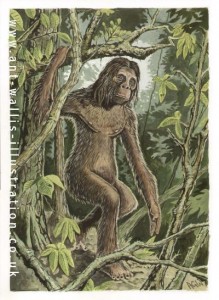It’s been seen by the locals for decades. Many tourists and scientists have seen the creatures as well.
Orang Pendek (Indonesian for “short person”) has been spotted in the remote island of Sumatra, in Indonesia. Looking like a mini Bigfoot, the Orang Pendek has been described as monkey like features, with a human like body.
I’m more inclined in believing the existence of this creature, given that in 2003 (I think it was 2003) that the discovery of Homo floreciensis was made in a nearby island.
A group of British explorers and scientists from the North-Devon based Centre for Fortean Zoology (CFZ), the world’s largest mystery animal research organisation, is about to embark on an expedition in search of a yeti-like creature in Indonesia.
The four-man team will search the jungles of Sumatra for what locals call the “orang-pendek.”. The powerfully built, upright-walking beast may be related to both the orang-utan and the much larger yeti of mainland Asia.
In the same island chain remains of the tiny hominid known as Homo floresiensis were unearthed in 2003.
The Kubu people – an ancient race who were the first inhabitants of Sumatra – will aid the team. The tribe and their chief have seen the creature in their poorly explored jungle homelands.
Westerners have sighted the orang-pendek too, including Englishwoman Debbie Martyr, now head of the Indonesian tiger conservation group, and wildlife photographer Jeremy Holden.
Also reported in the same jungles are huge horned snakes said to be ten metres long, and a savage, golden cat with a stubby tail and large canine fangs.
The expedition’s zoologist, Richard Freeman, Zoological Director of the CFZ, said: “The orang-pendek is especially interesting as it is an ape that walks upright rather than on all fours. It may show us how our own ancestors first began bipedal locomotion.
“The cigau may be a surviving form of Homotherium or scimitar cat, which is a beast related to the better known sabre-toothed cats. Fossils of this animal have been found in Indonesia that are only 10,000 years old. In evolutionary or geological terms that is yesterday.
“The giant snakes, known as ‘nagas’ by the Kubu, may be a new species. There are horned snakes such as the rhinoceros viper and the horned viper, but these are small. The nagas of the Kubu are said to be ten metres long! The ‘horns’ are probably modified scales.
“New species are turning up in Indonesia all the time; it is the real life lost world.”
Team leader Adam Davis, together with Dr Chris Clark and Dave Archer, will join Mr Freeman.
You can follow the group’s adventures on line at the CFZ website on www. cfz.org.uk
Full source: North Devon Gazette





